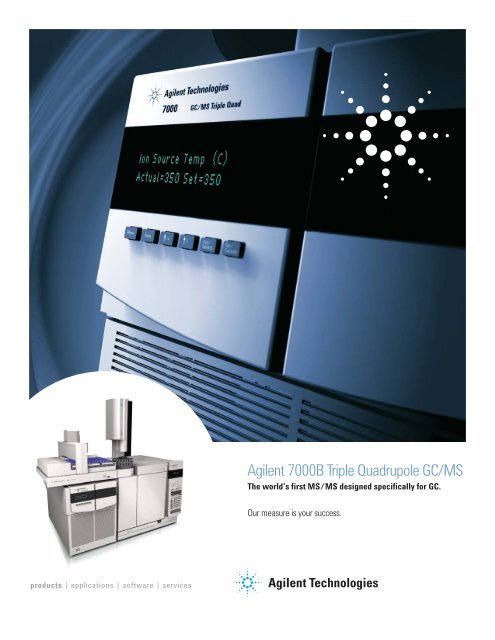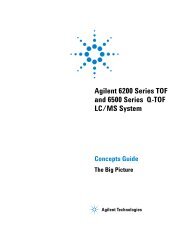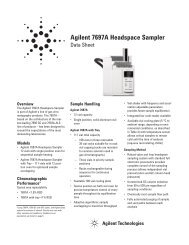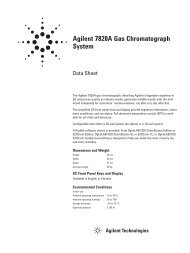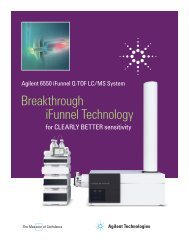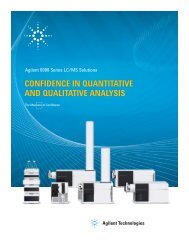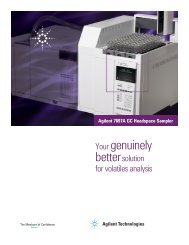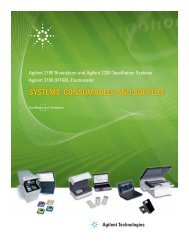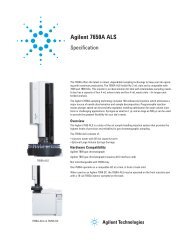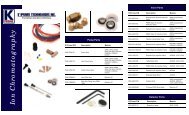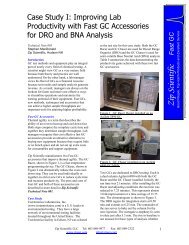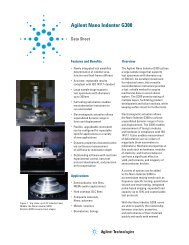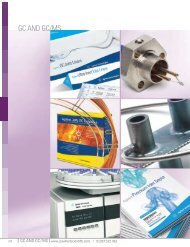Agilent 7000B Triple Quadrupole GC/MS - K'(Prime) Technologies
Agilent 7000B Triple Quadrupole GC/MS - K'(Prime) Technologies
Agilent 7000B Triple Quadrupole GC/MS - K'(Prime) Technologies
Create successful ePaper yourself
Turn your PDF publications into a flip-book with our unique Google optimized e-Paper software.
<strong>Agilent</strong> <strong>7000B</strong> <strong>Triple</strong> <strong>Quadrupole</strong> <strong>GC</strong>/<strong>MS</strong><br />
The world’s first <strong>MS</strong>/<strong>MS</strong> designed specifically for <strong>GC</strong>.<br />
Our measure is your success.<br />
products | applications | soft ware | services
<strong>Agilent</strong> <strong>7000B</strong> <strong>Triple</strong> <strong>Quadrupole</strong> <strong>GC</strong>/<strong>MS</strong><br />
Extraordinary sensitivity and selectivity—<br />
plus day-after-day reliability.<br />
<strong>Agilent</strong>’s new <strong>7000B</strong> <strong>Triple</strong> <strong>Quadrupole</strong> <strong>GC</strong>/<strong>MS</strong> delivers advanced high-speed <strong>GC</strong>/<strong>MS</strong>/<strong>MS</strong> quantitation for ultra-trace<br />
analysis of the most complex samples. Engineered from the ground up for ease of use and routine high performance<br />
operation, this is the world’s first <strong>MS</strong>/<strong>MS</strong> designed specifically for <strong>GC</strong> analyses.<br />
The triple quadrupole analyzer perfectly complements the front-end separation capabilities of the industry-leading <strong>Agilent</strong><br />
7890A <strong>GC</strong>. With new sample injection options and breakthrough Capillary Flow Technology, the powerful combination<br />
handles the most challenging analytical tasks quickly and efficiently—and is the ideal choice for labs requiring maximum<br />
sensitivity, maximum uptime and maximum productivity.<br />
The <strong>Agilent</strong> <strong>7000B</strong> <strong>Triple</strong> <strong>Quadrupole</strong> <strong>GC</strong>/<strong>MS</strong><br />
combines industry-leading reliability with<br />
femtogram-level sensitivity in complex matrices.<br />
2
Industry-leading sensitivity and selectivity<br />
Whether you are measuring pesticides in food and water, drugs<br />
in complex biological matrices or contaminants in environmental<br />
samples, you need consistent, ultra-trace detection limits. Analyte<br />
signal must be maximized; all sources of noise must be minimized.<br />
Every <strong>7000B</strong> component—source, quadrupoles, collision cell and<br />
detector—has been optimized to deliver:<br />
• Routine femtogram-level limits of detection and quantitation<br />
• Ultra-low noise<br />
• Superior selectivity<br />
Faster analysis, higher throughput<br />
Multi-compound screening methods place stringent demands on<br />
electronics, ion transmission, ion dissociation, firmware and software<br />
of the <strong>GC</strong>/<strong>MS</strong>/<strong>MS</strong> system. The <strong>7000B</strong> maintains excellent<br />
sensitivity and exceptional area precision even at a dwell time of<br />
1 msec and an acquisition speed of 500 transitions per second—<br />
with zero cross-talk between transitions. You will be able to screen<br />
and quantitate hundreds of analytes today and add more later to<br />
meet new method requirements.<br />
Day-after-day reliability and simple, robust operation<br />
Over several decades, in thousands of labs worldwide, <strong>Agilent</strong> <strong>MS</strong>D<br />
solutions have earned a legendary reputation for reliability and<br />
hassle-free operation. The <strong>7000B</strong> system’s advanced design<br />
incorporates proven, highly reliable <strong>Agilent</strong> technology developed<br />
specifically for <strong>GC</strong>/<strong>MS</strong> applications—and all of the new components<br />
adhere to the same exacting engineering standards. The result is<br />
a unique combination—an optimally robust <strong>GC</strong>, plus an optimally<br />
robust <strong>MS</strong>/<strong>MS</strong>, plus optimally robust software.<br />
New 7890A <strong>GC</strong> components<br />
New 7693 Autosampler, new multimode inlet<br />
(splitless, PTV, split) and high efficiency backflush<br />
deliver maximum analyte to the <strong>MS</strong> while<br />
protecting the system from high boiling matrix.<br />
New high-sensitivity electron<br />
ionization (EI) source<br />
More precursor ions entering the quadrupole<br />
result in improved S/N and precision.<br />
Solid inert materials—not a coating—and<br />
programmable temperature up to 350˚C ensure<br />
robust compatibility with complex matrices.<br />
Positive and Negative Chemical<br />
Ionization (CI) source<br />
The high molecular ion intensity of CI provides<br />
an ideal precursor ion for <strong>MS</strong>/<strong>MS</strong>. Based upon<br />
the stable, high sensitivity source of the 5975C<br />
<strong>MS</strong>D, the PCI/NCI source delivers trouble-free<br />
CI performance.<br />
Hot quartz hyperbolic quadrupoles<br />
High temperature is just as important for the<br />
quadrupole analyzer as it is for the ion source.<br />
<strong>Agilent</strong>’s gold-plated hyperbolic quartz<br />
quadrupole is the only analyzer that can be<br />
heated to 200˚C—without any loss of resolution<br />
or sensitivity.<br />
Proprietary hexapole collision cell<br />
Efficient dissociation, wide mass bandwidth ion<br />
transmission, zero cross-talk and novel helium<br />
quench noise reduction—all the benefits you<br />
need for high performance <strong>MS</strong>/<strong>MS</strong>.<br />
<strong>Agilent</strong> MassHunter software<br />
From simple, time-saving AutoTune to “Batch-ata-glance”<br />
review to customizable Excel reports,<br />
MassHunter software maximizes your<br />
<strong>GC</strong>/<strong>MS</strong>/<strong>MS</strong> productivity.<br />
To learn more about the <strong>Agilent</strong> <strong>7000B</strong> <strong>Triple</strong> <strong>Quadrupole</strong> <strong>GC</strong>/<strong>MS</strong>, visit www.agilent.com/chem/<strong>7000B</strong>. 3
Superior <strong>GC</strong>/<strong>MS</strong>/<strong>MS</strong> performance starts<br />
with the world’s best <strong>GC</strong>.<br />
<strong>MS</strong>/<strong>MS</strong> selectivity is a remarkable tool for complex<br />
matrix analysis, but its full value can’t be realized<br />
without accurate, robust operation of the <strong>GC</strong> inlet<br />
and column. As sample complexity increases, the<br />
front-end separation performance becomes even<br />
more important, and the <strong>GC</strong> must be able to deliver:<br />
• Precise sample introduction without mass<br />
discrimination for small and large injection volumes<br />
• Precise separations without large retention time<br />
shifts due to altered selectivity from matrix artifacts<br />
<strong>Agilent</strong>’s 7890 <strong>GC</strong> meets all these requirements—<br />
and delivers consistently efficient separations for<br />
your most difficult <strong>MS</strong>/<strong>MS</strong> analyses. Plus, of course,<br />
industry-leading <strong>Agilent</strong> reliability.<br />
The <strong>Agilent</strong> 7693A Automatic Liquid<br />
Sampler injects extra productivity into<br />
your gas chromatography.<br />
In addition to proprietary <strong>Agilent</strong> fast-injection and<br />
expanded 150-vial capacity, the all-new sampler offers<br />
a full range of enhanced capabilities, such as sandwich<br />
injections using up to 3 layers with air gap.<br />
Add a second injector and a heater/mixer/barcode<br />
reader, and the 7693A becomes a versatile sample<br />
preparation station that automates many bench tasks.<br />
4
<strong>Agilent</strong> Capillary Flow Technology makes<br />
column backflush simple<br />
Complex matrices can create a number of problems for <strong>GC</strong>/<strong>MS</strong>/<strong>MS</strong><br />
analyses: compromising separation efficiency, shortening column<br />
life and reducing ion source performance. Backflushing—reversing<br />
column flow immediately after the last compound of interest has<br />
eluted—can significantly improve your analytical results and<br />
maximize your return on your <strong>GC</strong>/<strong>MS</strong>/<strong>MS</strong> investment.<br />
Backflush with the new<br />
Purged Ultimate Union.<br />
This new ultra-inert, lowmass,<br />
low-dead volume device<br />
guarantees optimal peak<br />
shapes and response for the<br />
most difficult analytes.<br />
<strong>Agilent</strong>’s novel Capillary Flow Technology takes the complexity<br />
out of column backflushing and makes this valuable technique<br />
simple and routine for any <strong>GC</strong>/<strong>MS</strong> lab. 1<br />
<strong>Agilent</strong> Capillary Benefits of backflushing<br />
• Extends column life by eliminating long, high temperature bake-out<br />
• Reduces the frequency of ion source cleaning by keeping column<br />
bleed and high boiling matrix out of the mass spectrometer<br />
• Improves retention time precision by eliminating carry-over that<br />
alters column selectivity<br />
• Increases sample throughput by reducing bake-out (in some<br />
configurations, bake-out can even begin before the analysis has<br />
been completed)<br />
Backflushing maintains sensitivity. The analysis of lipid peroxidation<br />
products in whole blood without backflush led to a rapid loss of<br />
sensitivity. Backflush not only eliminated the sensitivity degradation<br />
but actually allowed the system to slowly improve as the entire system<br />
baked out more completely. 2<br />
Multimode Inlet. <strong>Agilent</strong>’s stellar<br />
split/splitless inlet performance is<br />
now perfectly complemented by<br />
two additional injection modes:<br />
cold splitless, for extra sensitivity or<br />
maximum sensitivity large volume<br />
injection (LVI). Setup is easy, thanks<br />
to software that calculates proper<br />
inlet parameters.<br />
1<br />
Brochure 5989-9804EN: Reduce run time and increase laboratory throughput—Capillary Flow Technology Backflush<br />
2<br />
Application Note 5989-9359EN: Capillary Flow Technology for <strong>GC</strong>/<strong>MS</strong>: Efficacy of the Simple Tee Configuration for Robust Analysis Using Rapid Backflushing<br />
for Matrix Elimination<br />
To learn more about the <strong>Agilent</strong> <strong>7000B</strong> <strong>Triple</strong> <strong>Quadrupole</strong> <strong>GC</strong>/<strong>MS</strong>, visit www.agilent.com/chem/<strong>7000B</strong>. 5
Advanced <strong>MS</strong>/<strong>MS</strong> technologies designed<br />
specifically for <strong>GC</strong>.<br />
The high boiling molecules that flood out of the <strong>GC</strong> column at the end of the separation create special<br />
requirements for the ion source and the mass analyzer. In fact, for the complex matrices typically separated<br />
in <strong>GC</strong>/<strong>MS</strong>/<strong>MS</strong> methods, this concentration of high boilers often approaches a worst-case scenario.<br />
<strong>Agilent</strong>’s <strong>7000B</strong> system is the only <strong>MS</strong>/<strong>MS</strong> designed to operate at temperatures as high as 200ºC. Because<br />
the quadrupole can be kept at this high temperature and at vacuum, it stays clean even with the complex,<br />
high boiling samples—eliminating frequent time-consuming maintenance and ensuring superior mass<br />
analyzer performance.<br />
The ultra-low coefficient of expansion for quartz allows the quadrupoles to be heated without any significant<br />
change in dimensions—and without any loss of ion transmission or loss of resolution. As a result, <strong>Agilent</strong>’s hot<br />
quartz analyzer remains maintenance-free, even after years of high throughput analyses of complex samples.<br />
New “extraction” EI<br />
or PCI/NCI ion source<br />
Gold plated, heated, quartz, hyperbolic quadrupole<br />
New ramped-iris detector<br />
High pressure hexapole collision cell with<br />
helium quench gas<br />
Split Flow Turbo<br />
6
A collision cell optimized for <strong>GC</strong> applications<br />
Extractor Source<br />
w/Ramped Iris Detector<br />
Because the multiple reaction monitoring (MRM) process essentially eliminates<br />
all chemical noise, neutral noise from the highly energetic metastable helium<br />
is the primary <strong>GC</strong>/<strong>MS</strong>/<strong>MS</strong> noise source. <strong>Agilent</strong> engineers started with the<br />
proven collision cell design of the 6400 Series LC/<strong>MS</strong>/<strong>MS</strong> and retuned the<br />
dimensions and voltages for <strong>GC</strong> applications. They also added a novel helium<br />
quench gas technology, in which a small, supplemental flow of helium is mixed<br />
with nitrogen collision gas. This allows highly efficient dissociation, rapid refocusing<br />
of product ions, rapid clearance of the cell (for zero cross-talk)—as well<br />
as significant reduction of neutral noise.<br />
Standard Source<br />
& Detector mode<br />
New EI source and detector boost <strong>MS</strong> sensitivity.<br />
Sensitivity is improved across the entire mass range<br />
for even lower limits of detection.<br />
Measured collision cell clearing time less than 1 msec ensures zero cross-talk<br />
between transitions. (Ask for a copy of AS<strong>MS</strong> 2009 Poster MPZ 656: High Speed<br />
Quantitative <strong>GC</strong>/<strong>MS</strong>/<strong>MS</strong> Data Acquisition.)<br />
Dwell Time (msec) 10 5 3 2 1<br />
# Transitions 18 33 50 66 99<br />
Cycle Time 198 198 200 198 198<br />
MRM/sec 91 167 250 333 500<br />
n 10 10 10 10 10<br />
Average Area 37686 37673 37465 36887 35180<br />
SD Area 940 1925 1439 1557 1447<br />
% RSD 2.5% 5.1% 3.8% 4.2% 4.1%<br />
Precision, precision, precision.<br />
Sensitivity without precision can result in unacceptable<br />
MRM ratios and poor quantitation results. As<br />
<strong>MS</strong>/<strong>MS</strong> baseline noise approaches zero, signal-tonoise<br />
ratio (S/N) becomes almost meaningless as a<br />
measure of performance; under ultra-low noise conditions,<br />
RSD<br />
of peak response is a better benchmark. The <strong>7000B</strong><br />
delivers the essential precision that you need to<br />
make accurate qualitative and quantitative decisions,<br />
even at dwell times as low as 1 or 2 msec.<br />
To learn more about the <strong>Agilent</strong> <strong>7000B</strong> <strong>Triple</strong> <strong>Quadrupole</strong> <strong>GC</strong>/<strong>MS</strong>, visit www.agilent.com/chem/<strong>7000B</strong>. 7
<strong>Agilent</strong> MassHunter software helps you make the<br />
most of every analysis and every workday.<br />
MassHunter software seamlessly integrates acquisition, data analysis and reporting and makes it easy even<br />
for non-expert operators to take full advantage of the advanced capabilities of the <strong>Agilent</strong> <strong>7000B</strong> <strong>Triple</strong><br />
<strong>Quadrupole</strong> <strong>GC</strong>/<strong>MS</strong>. The powerful combination of MassHunter tools delivers accurate results, faster—enabling<br />
you to analyze more samples with less data review. Highlighted features include:<br />
• Dynamic MRM (available Q1, 2010) and Optimizer simplify method development<br />
• Compound-centric data discovery tools with sample-centric data navigation<br />
• Rapid “Batch at a Glance” data review<br />
• Easy-to-use parameter-less integration of <strong>GC</strong>/<strong>MS</strong> peaks<br />
• Outlier detection with over 20 user-selectable criteria<br />
• Customizable reporting with Microsoft Excel ® 2007 + XML<br />
Data processing for your other <strong>MS</strong>D<br />
and <strong>GC</strong> detectors<br />
In addition to supporting the advanced capabilities of the <strong>7000B</strong><br />
<strong>MS</strong>/<strong>MS</strong>, MassHunter also supports traditional <strong>GC</strong>/<strong>MS</strong> analyses:<br />
• Supports acquisition/processing of <strong>GC</strong> detectors on a 7000<br />
Series system and analysis of <strong>MS</strong>D data<br />
• EI spectral library searching using NIST, Wiley and <strong>Agilent</strong><br />
Retention Time Locked (RTL) library collections<br />
• Advanced analysis of unknowns using integrated deconvolution<br />
tools, retention index data and RTL databases<br />
Single screen acquisition and control. MassHunter’s instrument<br />
control panels will be instantly familiar to any <strong>Agilent</strong> <strong>GC</strong>/<strong>MS</strong><br />
user, so you’ll be productive right from day one. Consistent software<br />
across all <strong>Agilent</strong> <strong>MS</strong> platforms—<strong>GC</strong>, LC and ICP—helps to<br />
shorten learning curves and reduce training costs.<br />
8
“Batch at a Glance” review with outlier detection. Flexible spreadsheet organization of the data is complemented<br />
by color-coded outlier detection that draws your attention to results that require closer inspection. Click on a result,<br />
and all associated peaks, spectra and calibration data are immediately displayed. Additional pop-up information is<br />
available for most data.<br />
Add tables and<br />
graphics using<br />
tool buttons<br />
Print preview<br />
Drag and drop<br />
columns from<br />
XML results<br />
Use Excel<br />
number<br />
formatting<br />
Use conditional<br />
formatting for<br />
Outlier flagging<br />
Format headers &<br />
footers using Excel<br />
Flexible, fully customizable reports. MassHunter utilizes XML and Microsoft Excel to provide powerful<br />
reporting capabilities. A wide range of application-specific templates or customized reports are available<br />
in this familiar Excel environment.<br />
To learn more about the <strong>Agilent</strong> <strong>7000B</strong> <strong>Triple</strong> <strong>Quadrupole</strong> <strong>GC</strong>/<strong>MS</strong>, visit www.agilent.com/chem/<strong>7000B</strong>.<br />
9
Advanced <strong>GC</strong> and <strong>MS</strong>/<strong>MS</strong> technologies translate<br />
into everyday high performance.<br />
<strong>MS</strong>/<strong>MS</strong> techniques are most often cited for consistent, ultra-low detection limits with very complex sample<br />
matrices. Multi-target screening methods—pesticide residues in foods, drugs in biological fluids and environmental<br />
contaminants in soil and water—have dominated much of the literature. But what’s often overlooked is that any<br />
SIM method can benefit from <strong>MS</strong>/<strong>MS</strong>, with better qualitative and quantitative results. Benefits include:<br />
• Elimination of chemical and neutral noise in the spectral region of the product ions—translating into lower<br />
detection limits than SIM<br />
• Higher probability of a more unique (more selective) product ion—translating into fewer false negatives<br />
and false positives than SIM<br />
For complex samples, even isotope ions (A+1, A+2, etc.) of intense matrix peaks can cause interference with<br />
SIM methods. <strong>MS</strong>/<strong>MS</strong> delivers detection limits that are lower than SIM without these sources of interference.<br />
Abundance<br />
650<br />
600<br />
550<br />
500<br />
450<br />
400<br />
350<br />
300<br />
250<br />
200<br />
150<br />
100<br />
50<br />
SIM<br />
Counts<br />
x10 4<br />
0.9<br />
0.8<br />
0.7<br />
0.6<br />
0.5<br />
0.4<br />
0.3<br />
0.2<br />
0.1<br />
0<br />
Ratio=23.3<br />
MRM<br />
MRM<br />
S/N = 446<br />
0<br />
11.70 11.80 11.90 12.00 12.10 12.20 12.30 12.40 12.50 12.60 12.70 12.80<br />
Time<br />
11.8 11.9 12 12.1 12.2 12.3<br />
Aquisition Time (min)<br />
Abundance<br />
750<br />
700<br />
650<br />
600<br />
550<br />
500<br />
450<br />
400<br />
350<br />
300<br />
250<br />
200<br />
150<br />
100<br />
50<br />
0<br />
11.70 11.80 11.90 12.00 12.10 12.20 12.30 12.40 12.50 12.60 12.70<br />
Time<br />
Counts<br />
x10 3 8<br />
7<br />
6<br />
5<br />
4<br />
3<br />
2<br />
1<br />
0<br />
Ratio=23.6<br />
11.8 11.9 12 12.1 12.2 12.3<br />
Aquisition Time (min)<br />
S/N = 456<br />
Abundance<br />
600<br />
550<br />
500<br />
450<br />
400<br />
350<br />
300<br />
250<br />
200<br />
150<br />
100<br />
50<br />
0<br />
11.70 11.80 11.90 12.00 12.10 12.20 12.30 12.40 12.50 12.60 12.70 12.80<br />
Time<br />
Counts<br />
x10 4<br />
1.2<br />
1.1<br />
1<br />
0.9<br />
0.8<br />
0.7<br />
0.6<br />
0.5<br />
0.4<br />
0.3<br />
0.2<br />
0.1<br />
0<br />
-0.1<br />
Ratio=24.0<br />
11.8 11.9 12 12.1 12.2 12.3<br />
Aquisition Time (min)<br />
S/N = 260<br />
Consistent <strong>MS</strong>/<strong>MS</strong> results, independent of matrix. Analysis of spiked p,p’-DDE at 10 ppb using <strong>Agilent</strong> J&W HP-5ms Ultra<br />
Inert columns. All injections are 1 µL. SIM m/z 246. MRM transition 246.0 176.1. 1<br />
1<br />
Application Note 5990-3578EN: A Method for the Trace Analysis<br />
of 175 Pesticides Using the <strong>Agilent</strong> <strong>Triple</strong> <strong>Quadrupole</strong> <strong>GC</strong>/<strong>MS</strong>.<br />
10
River Water 1 ng/ml<br />
*10.381<br />
1 2<br />
1<br />
*10.899<br />
0.8<br />
0.6<br />
*12.904<br />
*13.383<br />
0.4<br />
0.2<br />
River Water 0.04 - 0.15 ng/ml<br />
3.5<br />
3<br />
*10.377<br />
1 2<br />
2.5<br />
2<br />
1.5<br />
1<br />
0.5<br />
*10.9.3<br />
*13.386<br />
*12.911<br />
10<br />
10.5 11 11.5 12 12.5 13 13.5 14 14.5<br />
Outstanding sensitivity for PAHs in river water. Upper chromatogram:<br />
3 pg loading ( 1 ppb) of a polycyclic aromatic hydrocarbon (PAH)<br />
standard mixture. Lower chromatogram: PAHs in a river water sample<br />
at 0.04–0.15 ppb, or 120–450 fg on column. Reconstructed Total Ion<br />
Current Chromatogram (RTICC) from EI-MRM analysis.<br />
Ultra-trace quantification of THC acid with NCI<br />
Mode/Ammonia. Reconstructed MRM chromatogram<br />
for a standard of carboxy-tetrahydrocannbinol-TFA<br />
derivative (1 pg sample; 40 fg on column). The quantifying<br />
transition is m/z 590.0 422.0, and the qualifying<br />
transition is m/z 422.0 402.0 (22% of the peak area<br />
of the quantifying transition).<br />
For more information about the <strong>MS</strong>/<strong>MS</strong> analysis of pesticides, PCBs, nitro-PAHs, organo-tins, melamine, drug<br />
screens, PBDE fire retardants, steroids and other compounds in matrices such as fruits, vegetables, biota,<br />
infant formula, traditional Chinese medicines, body fluids, water and air, please contact your <strong>Agilent</strong> sales<br />
representative or the <strong>Agilent</strong> website.<br />
<strong>MS</strong>/<strong>MS</strong> selectivity and sensitivity enhance your productivity equation<br />
There is another, practical side to <strong>MS</strong>/<strong>MS</strong>: <strong>MS</strong>/<strong>MS</strong> selectivity and sensitivity let you adjust other aspects of the<br />
workflow to increase your lab’s productivity. For example:<br />
<strong>MS</strong>/<strong>MS</strong> sensitivity<br />
• Allows separations with less sample injected on-column, requiring less maintenance for the inlet, column and source<br />
<strong>MS</strong>/<strong>MS</strong> selectivity<br />
• Enables less sample preparation<br />
• Allows use of shorter, lower resolution columns, for faster analysis cycles and quicker bakeout or backflush<br />
• Provides faster and easier peak integration for streamlined data review and more confident analysis<br />
In fact, for many labs, <strong>MS</strong>/<strong>MS</strong> productivity gains can offset the incremental purchase price of a <strong>GC</strong>/<strong>MS</strong>/<strong>MS</strong> during the<br />
first year of the 10-year guaranteed product life of the <strong>7000B</strong> system!<br />
To learn more about the <strong>Agilent</strong> <strong>7000B</strong> <strong>Triple</strong> <strong>Quadrupole</strong> <strong>GC</strong>/<strong>MS</strong>, visit www.agilent.com/chem/<strong>7000B</strong>.<br />
11
Faster, better <strong>GC</strong>/<strong>MS</strong> results with<br />
<strong>Agilent</strong> J&W Ultra Inert columns<br />
<strong>Agilent</strong>’s new line of Ultra-Inert <strong>GC</strong><br />
columns are specifically tailored<br />
to meet the demands of <strong>GC</strong>/<strong>MS</strong>/<strong>MS</strong>.<br />
They feature exceptionally low<br />
column bleed and the highest<br />
degree of column inertness—<br />
providing maximum analyte transfer to the detector, better<br />
peak shapes for active compounds, fast baseline stabilization<br />
for minimized conditioning time and excellent thermal<br />
stability for reduced instrument downtime.<br />
<strong>Agilent</strong> certified <strong>MS</strong> supplies help keep<br />
routine maintenance routine<br />
Our capillary column ferrules, O-rings and septa are packaged<br />
to remain clean and ready for use. An exclusive<br />
non- stick plasma coating on our premium inlet septa and<br />
pre-cleaned O-rings makes maintenance quicker and<br />
easier—no unscheduled inlet maintenance due to residue<br />
on the inlet surface and shorter bakeout times after preventive<br />
maintenance, so you can start running samples sooner.<br />
For more information<br />
Learn more:<br />
www.agilent.com/chem/<strong>7000B</strong><br />
Buy online:<br />
www.agilent.com/chem/store<br />
Find an <strong>Agilent</strong> customer center in your country:<br />
www.agilent.com/chem/contactus<br />
U.S. and Canada<br />
1-800-227-9770<br />
agilent_inquiries@agilent.com<br />
Europe<br />
info_agilent@agilent.com<br />
Asia Pacific<br />
inquiry_lsca@agilent.com<br />
<strong>Agilent</strong> Services keep your lab running<br />
at peak productivity<br />
With a 98% customer satisfaction rating, <strong>Agilent</strong>’s service<br />
engineers are the most respected—and best-trained—in the<br />
industry. Whether you need support for a single instrument or<br />
a multi-lab, multi-vendor operation, we can help you solve<br />
problems quickly, increase your uptime and optimize your<br />
lab’s resources.<br />
Research use only. Information, descriptions and specifications in this publication are<br />
subject to change without notice. <strong>Agilent</strong> <strong>Technologies</strong> shall not be liable for errors<br />
contained herein or for incidental or consequential damages in connection with the<br />
furnishing, performance or use of this material.<br />
© <strong>Agilent</strong> <strong>Technologies</strong>, Inc. 2010<br />
Printed in USA May 15, 2010<br />
5990-4584EN<br />
• On-site preventive maintenance that ensures dependable<br />
system operation and minimizes unplanned downtime<br />
• Remote diagnostic and monitoring capabilities that give you<br />
additional “uptime insurance”<br />
• Rapid, expert troubleshooting and repair for <strong>Agilent</strong> as well<br />
as non-<strong>Agilent</strong> instruments<br />
• Expert installation, familiarization and advanced training to<br />
get you up and running as quickly as possible


